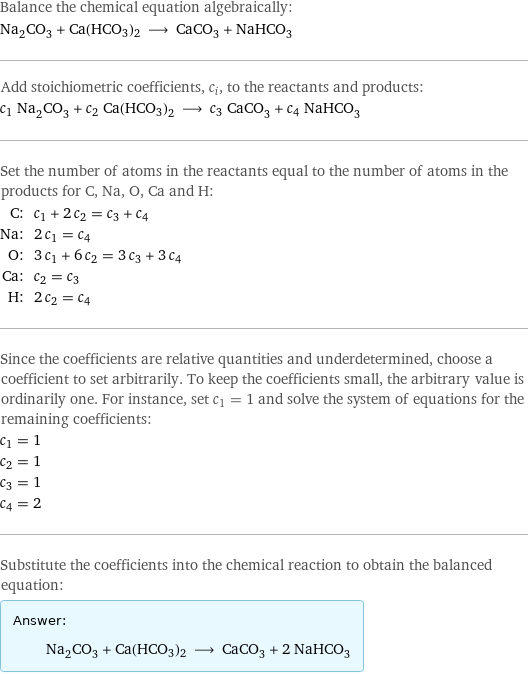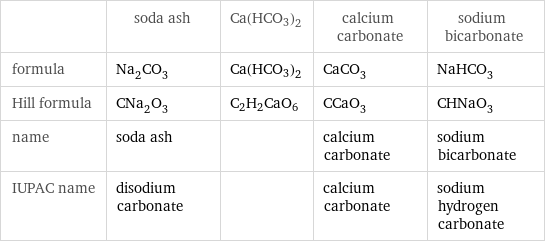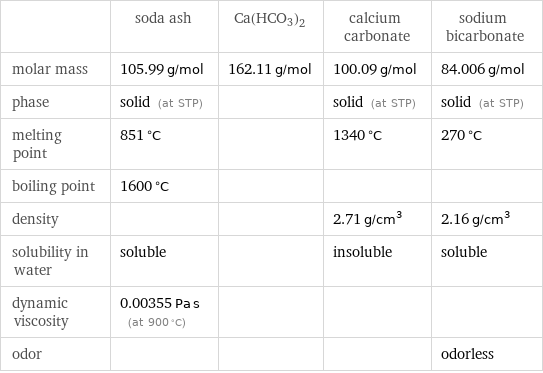Input interpretation

Na_2CO_3 soda ash + Ca(HCO3)2 ⟶ CaCO_3 calcium carbonate + NaHCO_3 sodium bicarbonate
Balanced equation

Balance the chemical equation algebraically: Na_2CO_3 + Ca(HCO3)2 ⟶ CaCO_3 + NaHCO_3 Add stoichiometric coefficients, c_i, to the reactants and products: c_1 Na_2CO_3 + c_2 Ca(HCO3)2 ⟶ c_3 CaCO_3 + c_4 NaHCO_3 Set the number of atoms in the reactants equal to the number of atoms in the products for C, Na, O, Ca and H: C: | c_1 + 2 c_2 = c_3 + c_4 Na: | 2 c_1 = c_4 O: | 3 c_1 + 6 c_2 = 3 c_3 + 3 c_4 Ca: | c_2 = c_3 H: | 2 c_2 = c_4 Since the coefficients are relative quantities and underdetermined, choose a coefficient to set arbitrarily. To keep the coefficients small, the arbitrary value is ordinarily one. For instance, set c_1 = 1 and solve the system of equations for the remaining coefficients: c_1 = 1 c_2 = 1 c_3 = 1 c_4 = 2 Substitute the coefficients into the chemical reaction to obtain the balanced equation: Answer: | | Na_2CO_3 + Ca(HCO3)2 ⟶ CaCO_3 + 2 NaHCO_3
Structures

+ Ca(HCO3)2 ⟶ +
Names

soda ash + Ca(HCO3)2 ⟶ calcium carbonate + sodium bicarbonate
Equilibrium constant
![Construct the equilibrium constant, K, expression for: Na_2CO_3 + Ca(HCO3)2 ⟶ CaCO_3 + NaHCO_3 Plan: • Balance the chemical equation. • Determine the stoichiometric numbers. • Assemble the activity expression for each chemical species. • Use the activity expressions to build the equilibrium constant expression. Write the balanced chemical equation: Na_2CO_3 + Ca(HCO3)2 ⟶ CaCO_3 + 2 NaHCO_3 Assign stoichiometric numbers, ν_i, using the stoichiometric coefficients, c_i, from the balanced chemical equation in the following manner: ν_i = -c_i for reactants and ν_i = c_i for products: chemical species | c_i | ν_i Na_2CO_3 | 1 | -1 Ca(HCO3)2 | 1 | -1 CaCO_3 | 1 | 1 NaHCO_3 | 2 | 2 Assemble the activity expressions accounting for the state of matter and ν_i: chemical species | c_i | ν_i | activity expression Na_2CO_3 | 1 | -1 | ([Na2CO3])^(-1) Ca(HCO3)2 | 1 | -1 | ([Ca(HCO3)2])^(-1) CaCO_3 | 1 | 1 | [CaCO3] NaHCO_3 | 2 | 2 | ([NaHCO3])^2 The equilibrium constant symbol in the concentration basis is: K_c Mulitply the activity expressions to arrive at the K_c expression: Answer: | | K_c = ([Na2CO3])^(-1) ([Ca(HCO3)2])^(-1) [CaCO3] ([NaHCO3])^2 = ([CaCO3] ([NaHCO3])^2)/([Na2CO3] [Ca(HCO3)2])](../image_source/1a31155108e9c96c9d77d8f75718d5d5.png)
Construct the equilibrium constant, K, expression for: Na_2CO_3 + Ca(HCO3)2 ⟶ CaCO_3 + NaHCO_3 Plan: • Balance the chemical equation. • Determine the stoichiometric numbers. • Assemble the activity expression for each chemical species. • Use the activity expressions to build the equilibrium constant expression. Write the balanced chemical equation: Na_2CO_3 + Ca(HCO3)2 ⟶ CaCO_3 + 2 NaHCO_3 Assign stoichiometric numbers, ν_i, using the stoichiometric coefficients, c_i, from the balanced chemical equation in the following manner: ν_i = -c_i for reactants and ν_i = c_i for products: chemical species | c_i | ν_i Na_2CO_3 | 1 | -1 Ca(HCO3)2 | 1 | -1 CaCO_3 | 1 | 1 NaHCO_3 | 2 | 2 Assemble the activity expressions accounting for the state of matter and ν_i: chemical species | c_i | ν_i | activity expression Na_2CO_3 | 1 | -1 | ([Na2CO3])^(-1) Ca(HCO3)2 | 1 | -1 | ([Ca(HCO3)2])^(-1) CaCO_3 | 1 | 1 | [CaCO3] NaHCO_3 | 2 | 2 | ([NaHCO3])^2 The equilibrium constant symbol in the concentration basis is: K_c Mulitply the activity expressions to arrive at the K_c expression: Answer: | | K_c = ([Na2CO3])^(-1) ([Ca(HCO3)2])^(-1) [CaCO3] ([NaHCO3])^2 = ([CaCO3] ([NaHCO3])^2)/([Na2CO3] [Ca(HCO3)2])
Rate of reaction
![Construct the rate of reaction expression for: Na_2CO_3 + Ca(HCO3)2 ⟶ CaCO_3 + NaHCO_3 Plan: • Balance the chemical equation. • Determine the stoichiometric numbers. • Assemble the rate term for each chemical species. • Write the rate of reaction expression. Write the balanced chemical equation: Na_2CO_3 + Ca(HCO3)2 ⟶ CaCO_3 + 2 NaHCO_3 Assign stoichiometric numbers, ν_i, using the stoichiometric coefficients, c_i, from the balanced chemical equation in the following manner: ν_i = -c_i for reactants and ν_i = c_i for products: chemical species | c_i | ν_i Na_2CO_3 | 1 | -1 Ca(HCO3)2 | 1 | -1 CaCO_3 | 1 | 1 NaHCO_3 | 2 | 2 The rate term for each chemical species, B_i, is 1/ν_i(Δ[B_i])/(Δt) where [B_i] is the amount concentration and t is time: chemical species | c_i | ν_i | rate term Na_2CO_3 | 1 | -1 | -(Δ[Na2CO3])/(Δt) Ca(HCO3)2 | 1 | -1 | -(Δ[Ca(HCO3)2])/(Δt) CaCO_3 | 1 | 1 | (Δ[CaCO3])/(Δt) NaHCO_3 | 2 | 2 | 1/2 (Δ[NaHCO3])/(Δt) (for infinitesimal rate of change, replace Δ with d) Set the rate terms equal to each other to arrive at the rate expression: Answer: | | rate = -(Δ[Na2CO3])/(Δt) = -(Δ[Ca(HCO3)2])/(Δt) = (Δ[CaCO3])/(Δt) = 1/2 (Δ[NaHCO3])/(Δt) (assuming constant volume and no accumulation of intermediates or side products)](../image_source/34e26eca5f5de9e39818ca8f2baa9a47.png)
Construct the rate of reaction expression for: Na_2CO_3 + Ca(HCO3)2 ⟶ CaCO_3 + NaHCO_3 Plan: • Balance the chemical equation. • Determine the stoichiometric numbers. • Assemble the rate term for each chemical species. • Write the rate of reaction expression. Write the balanced chemical equation: Na_2CO_3 + Ca(HCO3)2 ⟶ CaCO_3 + 2 NaHCO_3 Assign stoichiometric numbers, ν_i, using the stoichiometric coefficients, c_i, from the balanced chemical equation in the following manner: ν_i = -c_i for reactants and ν_i = c_i for products: chemical species | c_i | ν_i Na_2CO_3 | 1 | -1 Ca(HCO3)2 | 1 | -1 CaCO_3 | 1 | 1 NaHCO_3 | 2 | 2 The rate term for each chemical species, B_i, is 1/ν_i(Δ[B_i])/(Δt) where [B_i] is the amount concentration and t is time: chemical species | c_i | ν_i | rate term Na_2CO_3 | 1 | -1 | -(Δ[Na2CO3])/(Δt) Ca(HCO3)2 | 1 | -1 | -(Δ[Ca(HCO3)2])/(Δt) CaCO_3 | 1 | 1 | (Δ[CaCO3])/(Δt) NaHCO_3 | 2 | 2 | 1/2 (Δ[NaHCO3])/(Δt) (for infinitesimal rate of change, replace Δ with d) Set the rate terms equal to each other to arrive at the rate expression: Answer: | | rate = -(Δ[Na2CO3])/(Δt) = -(Δ[Ca(HCO3)2])/(Δt) = (Δ[CaCO3])/(Δt) = 1/2 (Δ[NaHCO3])/(Δt) (assuming constant volume and no accumulation of intermediates or side products)
Chemical names and formulas

| soda ash | Ca(HCO3)2 | calcium carbonate | sodium bicarbonate formula | Na_2CO_3 | Ca(HCO3)2 | CaCO_3 | NaHCO_3 Hill formula | CNa_2O_3 | C2H2CaO6 | CCaO_3 | CHNaO_3 name | soda ash | | calcium carbonate | sodium bicarbonate IUPAC name | disodium carbonate | | calcium carbonate | sodium hydrogen carbonate
Substance properties

| soda ash | Ca(HCO3)2 | calcium carbonate | sodium bicarbonate molar mass | 105.99 g/mol | 162.11 g/mol | 100.09 g/mol | 84.006 g/mol phase | solid (at STP) | | solid (at STP) | solid (at STP) melting point | 851 °C | | 1340 °C | 270 °C boiling point | 1600 °C | | | density | | | 2.71 g/cm^3 | 2.16 g/cm^3 solubility in water | soluble | | insoluble | soluble dynamic viscosity | 0.00355 Pa s (at 900 °C) | | | odor | | | | odorless
Units
